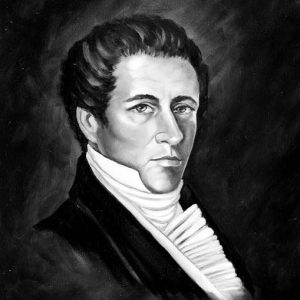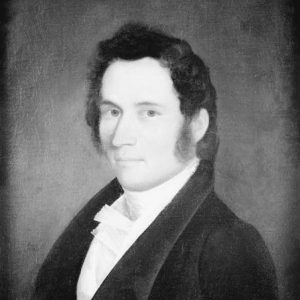calsfoundation@cals.org
Antiquarian and Natural History Society of Arkansas
One of Arkansas’s first attempts to preserve its history was organized by a group of “gentlemen naturalists” and state leaders who came together in Little Rock (Pulaski County) during the autumn of 1837. They called themselves the Antiquarian and Natural History Society of Arkansas. Approximately thirty early Arkansans were known members of the society. At least nine were lawyers, five were doctors, and three were surveyors; other members included a merchant, a newspaper editor, a hotel owner, and several planters whose occupations are unknown. The group was active for several years, but its collection was eventually scattered and lost.
A notice was posted in early May 1837, calling upon “Friends of Science” to meet at what is now the Old State House on May 12. That was the first meeting of the Antiquarian and Natural History Society of Arkansas, which was then officially organized on May 16. The society was formally incorporated through an act of the Arkansas General Assembly on November 25, 1837, following an address “on the nature and objects of the Society,” given by candlelight in the Senate chamber of the Old State House on November 21, 1837.
The society’s main function at its inception was to collect objects “of vital importance to the people of this state,” for the “encouragement of learning and the dissemination of useful and entertaining knowledge.” The society’s regular meetings were held on the first Monday of each month. Like other organizations of its kind, the Antiquarian and Natural History Society was governed by a board of officers and trustees elected from within its group of members. The society’s first leaders were Little Rock City Council member and Virginia native Dr. David Holt; the Reverend William Wilson Stevenson of South Carolina, who had moved to Batesville (Independence County); and Arkansas legislator turned land speculator William Cummins of Pulaski County.
Annual membership fees for the society at its creation were fixed at five dollars per year per member. Under the group’s charter, its members were allowed to acquire items for its collection by purchase, as a gift, in trade for land, and in various other ways, including donations from the public. However, these contributions were not to exceed a value of $10,000 annually.
By 1841, a cabinet kept by the society contained various types of fossils, Native American artifacts and relics, and Spanish coins. On August 25, 1841, a list published in the Arkansas Gazette stated that several “earthen vessels of curious and often labored workmanship” had been found in a mound located in southeastern Arkansas and had been donated by Richard D’Cantillon Collins. One of them supposedly closely resembled “an enormous bullfrog.” Also listed were items donated to the society by William E. Woodruff (founder of the Arkansas Gazette), including a massive vertebra found on the plantation of Daniel Roland thirty miles south of Little Rock. The huge bone reportedly measured twelve and one-half inches long, meaning that the animal it came from was at least forty feet long and eighteen feet tall. Rev. Stevenson donated an “Indian implement,” A. N. Sabin donated some Indian relics found “three feet underground” at Hot Springs (Garland County), and Woodruff again made the list by donating a rock etched with an “old Spanish inscription.” In addition to Collins and Woodruff, other Arkansas founding fathers who were members included Governor James Sevier Conway, Thomas W. Newton, Samuel Calhoun Roane, Samuel W. Rayburn, Absalom Fowler, Dr. Charles Dean, Dr. William Gaulding, James De Baum, and Dr. Alden Sprague.
Woodruff was elected treasurer of the society in January 1842, and Stevenson became its president. New members that year included Arkansas’s first governor, James S. Conway; lawyer Absalom Fowler; Samuel C. Roane; and Thomas W. Newton—all influential figures in Arkansas’s early days. In September 1842, the society published society member Dr. W. Byrd Powell’s pamphlet Geological Report upon the Fourche Cove and Its Immediate Vicinity. Powell presented his findings along with some specimens he took from the Fourche Cove, and spectators could purchase a copy of Powell’s report for twenty-five cents. The report of George W. Featherstonehaugh on the geology of Missouri and Arkansas was also published by the society, which helped spark interest in the rich resources and landscape of Arkansas in the early statehood period.
Dr. William Goulding was the main curator of the society’s ever-growing collection of relics, fossils, coins, bones, and other curiosities until his death in 1841. By the summer of 1843, the society was on the decline. On June 14, 1843, a letter published in the Arkansas Gazette said that the society had held its meetings regularly for a year or two, but these meetings had stopped, and the society was “in the agonies of premature death.”
After Goulding died, the collection continued to grow, and by 1849, when Stevenson left to take part in the California Gold Rush, all the items had to be moved to bigger venues and eventually ended up being deposited at the State House. With little security, many small items ended up being pocketed by visitors. In response to this, the collection went to the care of the Little Rock Lyceum, then to a Captain George Alexander, who eventually took the collection with him to Louisiana in 1874. After that, all traces of the collection were lost.
Ultimately, the Antiquarian and Natural History Society of Arkansas did little to realize its goals of preserving Arkansas artifacts and history, but it may have influenced other Arkansans to take up that cause and build what became the state’s first official museums and historical preservation agencies.
For additional information:
Hendrickson, Walter B. “Culture in Early Arkansas: The Antiquarian and Natural History Society of Arkansas.” Arkansas Historical Quarterly 17 (Spring 1958): 21–32.
Sherwood, Diana. “Historical Societies in Arkansas.” Arkansas Historical Quarterly 11 (Summer 1952): 131–136.
Vaughan, Myra McAlmont. “First Historical Society of Arkansas.” In Publications of the Arkansas Historical Society, Vol. 2, edited by John Hugh Reynolds. Little Rock: Democrat Printing and Lithographing Co., 1908.
Cody Lynn Berry
University of Arkansas at Little Rock
 Historic Preservation
Historic Preservation Louisiana Purchase through Early Statehood, 1803 through 1860
Louisiana Purchase through Early Statehood, 1803 through 1860 James Conway
James Conway  William Woodruff
William Woodruff 



Comments
No comments on this entry yet.